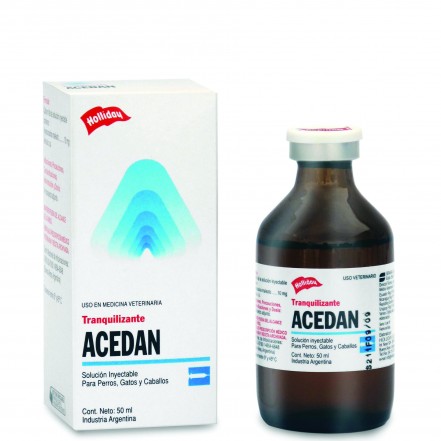Categories
- Anesthetic | Analeptic | Tranquilizer
- Anti-inflamatory
- Antibiotic
- Antimycotics
- Antiseptic Disinfectant
- Biomodulator
- Bird Medication
- Cardiological
- Dermatological
- External Antiparasitic
- Gastroenterological
- Geriatrical
- Health & Wellness
- Internal Antiparasitic
- Odontological
- Oncology Medication
- Ophthalmological
- Osteoarticular
- Otological
- Prescribed Diets
- Reproductive System
- Respiratory System
- Revitalizer
- Urinary System and Diuretics
Anestésicos | Analéptico | Tranquilizantes

ACEDAN
description
Neuroleptic tranquilizer injection.
presentation
50 mL vial .
action
It produces a state of passivity and calmness.
It reduces nervous excitability without causing bluntness.
It generates indifference to the environment, with decreased motor activity.
SECONDARY ACTIONS:
Blood pressure reduction by peripheral alpha receptor blockade.
indications
It facilitates animal handling in clinical-surgical and diagnostic maneuvers.
Pre-anesthetic medication.
Blood pressure reduction.
Urethral relaxation
.
formula
100 mL of the solution contains:
Acepromazine maleate 1 g
Excipients q.s.
dosage and administration
Dogs and cats: 0.1 mg/kg SC, IM or IV (slow) equivalent to 0.1 mL every 10 kg. WARNING: do not exceed a total of 3 mg by IM or IV route in dogs and a total of 1 mg in felines. Equines: 1.5 mL every 400 kg by IV, IM or SC route.
contraindications
Patients with hypersensitivity to acepromazine. Dehydrated or hypovolemic patients. Hypertrophic cardiomyopathies due to peripheral vasodilation. Animals with tetanus, organophosphate or strychnine poisoning. Convulsive disorders. Myelograms.
collateral damage
Peripheral vasodilation and, consequently, arterial hypotension. Bradycardia. Prolapsed nictitating membrane gland. In some animals, it can cause generalized CNS stimulation (paradoxical reaction). In equines, adult breeding stallions can show prolapsed penis.
restrictions on use
Its administration to females with advanced pregnancy is not advisable. Puppies and kittens younger than 2 months.
Caution
Use with caution by administering the lowest dose in animals that are younger than 6 months, geriatric, weak, or with heart, liver or kidney failure. Reduce the dose by 50% in sensitive breeds such as boxer, brachycephalic, giant and greyhound breeds. In case of acute hypotension, treat the animal with fluid therapy until stabilization.

